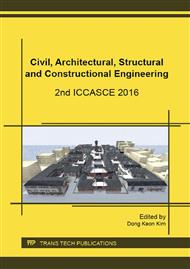p.98
p.104
p.111
p.119
p.125
p.131
p.137
p.145
p.151
Hydrodynamic Pressure on Submerged Floating Tunnel under the P-Wave
Abstract:
Based on the displacement potential functions, considering submarine rock and soil as elastic half-space, seawater as ideal fluid, anchors as springs, the formulae for determining the hydrodynamic pressure on submerged floating tunnel were deduced while the P-wave was incident. Subsequently, effects of different submarine rock and soil parameters (such as shear modulus, Poisson ratio) and different spring constants and spaces of the anchors on the hydrodynamic pressures were discussed. It could be concluded that for normal incidence, the shear modulus and the Poisson ratio of submarine rock and soil have no influence on the amplitude of the hydrodynamic pressure on SFT for. The peak value of the amplitude of the hydrodynamic pressure on SFT increases as the Poisson ratio of submarine rock and soil and the spring constant of anchor increases, decreases as the spacing of the anchor increases.
Info:
Periodical:
Pages:
125-130
Citation:
Online since:
November 2016
Authors:
Price:
Сopyright:
© 2017 Trans Tech Publications Ltd. All Rights Reserved
Share:
Citation:


